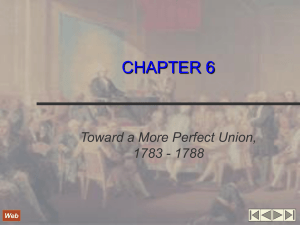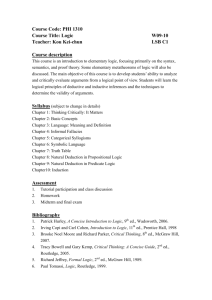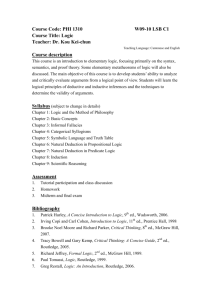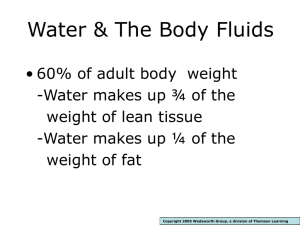Genetics
advertisement
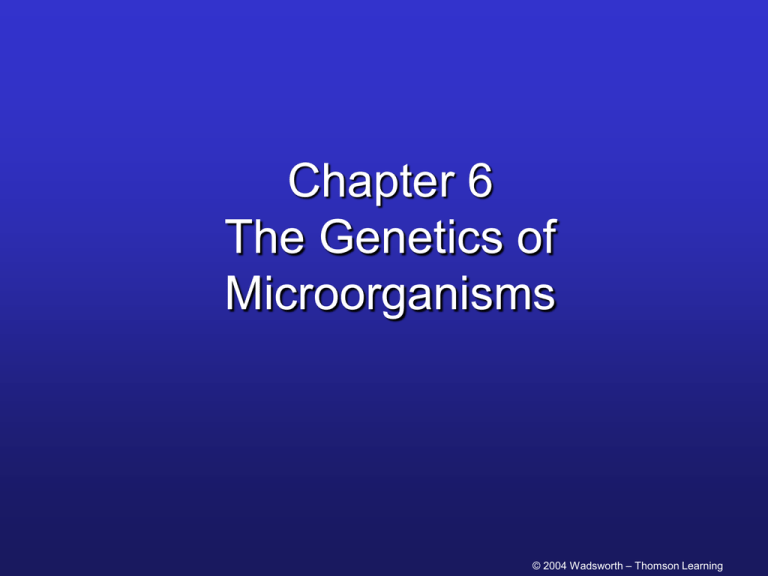
Chapter 6 The Genetics of Microorganisms © 2004 Wadsworth – Thomson Learning Structure of DNA • Two strands • Nucleotides – Hydrogen bonds between strands – Neighboring deoxyribose connected • 3’ of one deoxyribose to 5’ of next deoxyribose • Phosphate in between • Double helix • Base pairing – G and C – A and T Figure 6.1 © 2004 Wadsworth – Thomson Learning Roles of DNA • Replication – cell division – need accurate copy • Gene expression – DNA – RNA – Protein Figure 6.2 © 2004 Wadsworth – Thomson Learning DNA Replication • Semi-conservative – old strand-template – new strandcomplementary • Replication fork – – – – – multiple enzymes DNA unwinds exposes nucleotides synthesize new strand one direction: 5’ to 3’ Figure 6.3 © 2004 Wadsworth – Thomson Learning DNA Replication • Complementary nucleotides match (A=T; G=C) • DNA polymerase III binds nucleotides releasing pyrophosphate Figure 6.3 © 2004 Wadsworth – Thomson Learning Bacterial chromosomes • Replication of circular chromosome • Origin of replication – bubble forms – DNA unwinds • Replication occurs in both directions • Two replication forks • Continues until replication forks meet • Strands separate Figure 6.4 © 2004 Wadsworth – Thomson Learning Replication fork Figure 6.5 © 2004 Wadsworth – Thomson Learning DNA Replication • Leading strand – replication is continuous (5’ to 3’) • primase makes primer • DNA added to primer • fork opens and replication continues • Lagging strand – polymerization in only one direction • can’t go 3’ to 5’ – short segments synthesized (Okazaki fragments) • when fork opens, new primer is made • synthesis in direction away from fork • fragments are joined together by DNA ligase © 2004 Wadsworth – Thomson Learning Transcription • RNA polymerase binds DNA at site of promoter Figure 6.6 © 2004 Wadsworth – Thomson Learning Transcription • DNA unwinds • nucleotide bases are exposed Figure 6.6 © 2004 Wadsworth – Thomson Learning Transcription • ribonucleotides pair with exposed bases – uracil in RNA replaces thymine – U binds A • ribonucleotides are polymerized into growing RNA chain Figure 6.6 © 2004 Wadsworth – Thomson Learning Transcription • Termination sequence • Release of transcript • single strand RNA • DNA closes Figure 6.6 © 2004 Wadsworth – Thomson Learning Transcription • Role of RNA from transcription – mRNA • template which encodes the protein – tRNA • transfer amino acids used to build the protein – rRNA • part of ribosome which is the site of protein synthesis • All used for translation © 2004 Wadsworth – Thomson Learning Translation • Production of proteins • Based on genetic information of DNA • Genetic code – Codon has three nucleotide – Four different nucleotides – 64 possible combinations – 20 amino acids • Redundancy • Nonsense codons Figure 6.8 © 2004 Wadsworth – Thomson Learning Translation • tRNA – binds an amino acid • specific amino acid for each tRNA – Anticodon • recognizes codon • three nucleotide sequence in mRNA which encodes a specific amino acid – activated with ATP Figure 6.7 © 2004 Wadsworth – Thomson Learning Translation • Ribosome binds to mRNA – specific region – start codon • Methionine – Ribosome binding region • Shine-Dalgarno sequence Figure 6.9 © 2004 Wadsworth – Thomson Learning Translation • tRNA with appropriate anticodon and specific amino acid binds to the codon on the mRNA – A site • second tRNA binds in similar fashion – P site • two amino acids are joined in a peptide bond Figure 6.9 © 2004 Wadsworth – Thomson Learning Translation • Ribosome moves along mRNA • first tRNA without amino acid is removed • second tRNA with both amino acids moves to P site Figure 6.9 © 2004 Wadsworth – Thomson Learning Translation • New tRNA enters A site • Growing amino acid chain is transferred to new amino acid Figure 6.9 © 2004 Wadsworth – Thomson Learning Translation • steps repeat – ribosome moves – one codon at a time • protein chain – one amino acid added for every codon Figure 6.9 © 2004 Wadsworth – Thomson Learning Translation • Continues until nonsense (stop) codon is reached • no tRNA matches • ribosome is removed • protein chain is released Figure 6.9 © 2004 Wadsworth – Thomson Learning Transcription and Translation • Simultaneous transcription and translation • mRNA chain is transcribed • translation begins • multiple ribosomes on single mRNA – polysome Figure 6.10 © 2004 Wadsworth – Thomson Learning Regulation of genes • Transcription – Production of regulatory proteins • Bind DNA near the promoter • Example: Lactose operon – Interruption of transcription • Attenuation • Translation – Ribosomal proteins • Global regulation – Catabolite repression – Nitrogen regulation – Phosphorus regulation – Stringent response – Heat shock proteins © 2004 Wadsworth – Thomson Learning Transcriptional regulation lac operon • lacZ • lacY • lacA – regulated by lacI • Lactose absent – repressor binds – stops transcription Figure 6.11 © 2004 Wadsworth – Thomson Learning Transcriptional regulation • Lactose present – repressor bound by product of lactose • allolactose – transcription occurs – gene products of all genes are made Figure 6.11 © 2004 Wadsworth – Thomson Learning Attenuation • Histidine operon – Histidine present – Leader protein made • Translation occurring simultaneously with transcription • Requires histidine – Attenuator loop forms on mRNA • Displaces RNA polymerase • Stops transcription Figure 6.12a © 2004 Wadsworth – Thomson Learning Attenuation • Histidine absent – Leader protein not made • Not enough histidines to complete protein – Antiterminator loop forms • Prevents attenuator loop from forming • RNA polymerase continues Figure 6.12b © 2004 Wadsworth – Thomson Learning Regulation of translation • Expression of ribosomal proteins – Unused proteins bind to encoding mRNA – Inhibit translation Figure 6.13 © 2004 Wadsworth – Thomson Learning Two component regulation • Phosphorylation of sensor • Phosphate passed to response regulator • Response regulator reacts with DNA changing gene expression – Increase – decrease Figure 6.14 © 2004 Wadsworth – Thomson Learning Genetic Information • Genome – total DNA of a cell – most have single circular chromosome – some have linear chromosome • Plasmids – small, circular, extrachromosomal DNA • encode beneficial factors • resistance factors (antibiotic) • conjugative plasmids – transfer to other cells • Genotype: genetic makeup • Phenotype: appearance and function © 2004 Wadsworth – Thomson Learning Changes in Genetic Information • Mutations – chemical change in DNA • chemical mutagens – Bind DNA – Change in DNA • physical mutagens – UV light – Ionizing radiation • biological mutagens – Transposable elements » Insertion sequences » transposons Figure 6.16 © 2004 Wadsworth – Thomson Learning Consequence of mutations • Types of mutations – base substitution • wrong nucleotide – deletion mutation • Results – Lethal mutation – Conditional expressed mutations • nucleotides deleted – Inversion • reverses order of a segment – Transposition • moves a segment of DNA – Duplication • identical new segment Figure 6.15 © 2004 Wadsworth – Thomson Learning Physical mutagen--UV damage • UV light – stimulates neighboring bases to form dimers • thymine dimers – activate repair systems Figure 6.17 © 2004 Wadsworth – Thomson Learning Physical mutagen--UV damage • Thymine dimers distort the DNA structure • Enzymes remove the damaged nucleotides Figure 6.17 © 2004 Wadsworth – Thomson Learning Physical mutagen--UV damage • Repairs may result in incorrect nucleotide replacement • Mutation is result Figure 6.17 © 2004 Wadsworth – Thomson Learning Selecting and identifying mutants • Direct selection – Conditions favor growth of desired mutant – Growth of bacteria in presence of antibiotic – Only successful growth are mutants • Indirect selection – – – – Prevent growth of mutant Kill growing cells Desired mutants larger percentage of population Isolate mutants • Site-directed mutagenesis – Recombinant DNA manipulation © 2004 Wadsworth – Thomson Learning Selecting and identifying mutants • Brute strength – Screen large numbers – Replica plating • Transfer large numbers of colonies • Track growth Figure 6.18 © 2004 Wadsworth – Thomson Learning Ames Test Figure 6.19 © 2004 Wadsworth – Thomson Learning Transformation • DNA exits one cell, taken up by another cell – Natural • few bacteria take up DNA fragments – Artificial--induced in laboratory • useful tool for recombinant DNA technology Figure 6.20 © 2004 Wadsworth – Thomson Learning Conjugation • Conjugative plasmids – – – – plasmids transfer genetically encoded F plasmid in E. coli sex pilus connect two cells • one cell F+ • one cell FFigure 6.21 © 2004 Wadsworth – Thomson Learning Conjugation – One strand of plasmid DNA is broken (nicked) – replication begins – synthesized linear strand enters F- cell – linear strand is copied forming a complete plasmid – both cells are F+ Figure 6.21 © 2004 Wadsworth – Thomson Learning Transduction • Bacteriophage – virus that infects bacteria – reproduce in bacteria – some phages contain bacterial DNA • rare event • transducing particle – cell lysis and release • normal phage • transducing particles Figure 6.23 © 2004 Wadsworth – Thomson Learning Transduction – Transducing particles • infect other bacteria • inject bacterial DNA into new cell – genetic exchange • one bacteria cell to another – integration into chromosome Figure 6.23 © 2004 Wadsworth – Thomson Learning Eukaryotic Microorganisms • Genetic exchange – Similar to plants and animals – Haploid gametes fuse Figure 6.23 © 2004 Wadsworth – Thomson Learning
